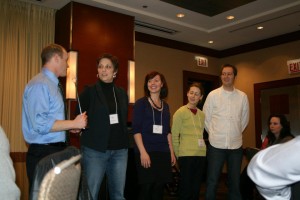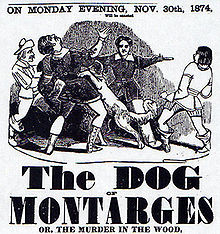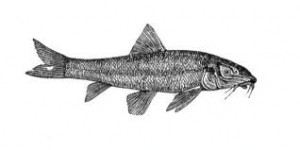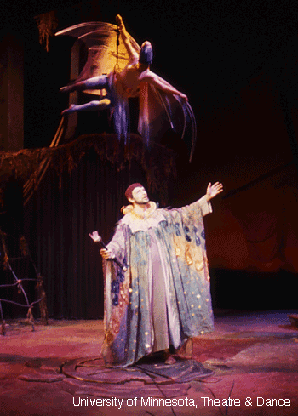
Andy White's "Yes It Is" Exercise at MATC 2012. Photo by Ann Haugo.
In Chicago during the first weekend of March, the Mid-America Theatre Conference held its annual meeting. Scott Magelssen reminded me that the conversation that eventually led to the creation of Theater Historiography: Critical Interventions started at this conference many years ago. To build on the link between the conference, the Bial-Magelssen edited collection, and this website, I decided to address my final blog to the response given by Heather Nathans to the theatre history symposium. In what follows, I’d like to replay a bit of that response, analyze some of the reaction it provoked, and offer my own thoughts on the role of theatre history and theatre historiography within the University.
Nathans played the part of respondent, which meant that she had to act the challenging role of what I call “the synthesizer.” From four days of panels on topics ranging from the accidental immolation of ballerinas to the archive of Penumbra Theatre Company to the economics of local Burning Man events, Nathans located a thru-line and shared her reflections with all of us. Her comments focused on issues of methodology. Specifically, she drew our attention to how we as theatre historians and historiographers talk about our individual objects of study. The underlying purpose of her remarks was not isolated to issues of scholarship but looked outward to our role as scholars of theatre within the University. Her response began with a hypothetical question: if we had a meeting with our University president, and asked him/her to tell us how we as theatre scholars think, for example, about race or identity formation, what would the president say? Nathans posited that the president would be at a loss, and that his/her inability to articulate an answer to that question reflects a shortcoming on our own parts. The president would likely not have a response because we as theatre scholars do not always do a good job explaining how we think about certain issues, how we go about our historical investigations, or how we differentiate ourselves from other practitioners such as art historians or ethnomusicologists.
This focus on methodology and its relationship to self-reflexivity certainly demands our attention. As audience members pointed out, within Nathans’s call for a more articulate framing of how we do what we do exists a pedagogical challenge. After all, as teachers we should be able to help our students learn the how in addition to the what. Theatre history, as a practice, requires an understanding of the research process as well as an understanding of the basic tenets of, say, the Cid controversy or the main elements of Ancient Greek tragedy. On top of that, and perhaps more obviously, theatre historians and historiographers must place ourselves within our work and formulate a clear notion of how we navigate the archives. Without wishing to challenge either of those beliefs, I would like to trouble another aspect of the group’s reaction to Nathans, as well as an underlying assumption as to the purpose of articulating how we do what we do.
Once the conversation opened up to include comments from the audience, the topic of conversation turned to use. If we develop the ability to explain how we do what we do, then we will be able to prove our use to the University. The vibe of the room transposed to a more lightweight and joyous resonance once people got behind this notion that theatre historians might be able to adequately express our value to the University, thereby securing our position within the liberal arts and, perhaps, gaining access to increased research funds. To be honest, my internal resonance clashed with the predominant tenor of the room at this point. I wondered if our segue from the how-ness of what we do to our use within the University pointed to an obfuscation of the discourse on use pervading the current “crisis.” While listening and reflecting on the discussion that unfolded there in that room, I began to imagine a different way of discussing our position within the University. Finally, some weeks later, I’ve put my thoughts into words and I offer this alternate perspective for your consideration.
To begin this alternate line of thought I’d like to summon Theodor W. Adorno’s essay “On Tradition” (Telos vol. 94 [Winter 93/94]: 75-82). In that work, Adorno explores the dialectic of tradition: on the one hand, a questionable value whose link to the past appears fruitless and useless because of the cult of the new which drives culture forward; on the other hand, an imported article to be valued, but valued only as a curiosity (75). University discourse presents us with both sides of this dialectic. We can see this by thinking about the place of theatre history within this discourse. Theatre history, as a discipline, seems to be out of date; as a practice, it appears as something that once had its place but now serves no clear purpose. At the same time, and because of its out-of-placeness, theatre history is a curiosity, an endeavor that unearths bizarre and titillating rituals from days gone by. The curiosity may lose its charm, however, and deflate into an unarticulated otherness. “The less the bourgeois principle tolerates otherness, the more urgently it appeals to tradition and cites what then appears from the outside as ‘value’” (76). Theatre historians face this shift today, as Nathans pointed out. As theatre history becomes more a curiosity and less of a stable link to the recognizable tradition of liberal arts education, the more it loses its value in the eyes of the University.
As we decide what to do about all of this, I would caution us against arguing within the terms laid down by the University discourse, a discourse thoroughly imbued with the logic of the market. Articulating how we do what we do as theatre historians or historiographers will lead to self-reflexive scholarship, there is little doubt of that. But we should not leverage our ability to articulate the specifics of our scholarly practice as a method for proving our usefulness or value within the University. By working to reveal our use, are we not capitulating to the logic of equal exchange, that principle derived from capitalist economic principles applied to all other social relations? If we prove that our discipline provides a service that has immediate applicability to the working on the University administration, then I think we have already conceded the very terms that we should be disputing.
Adorno’s negative dialectic practice reveals another was of thinking about this problem. “What fails to establish its immediate social usefulness in the market place,” he suggests, speaking specifically of the United States in the 1960s, “does not count and is forgotten. Even when someone dies, it is as if he had never lived; he is as replaceable as anything functional. Only what has no function is irreplaceable!” (75). This last sentence deserves out attention, partially because of the exclamation point but also, and more importantly, because it raises a counter-intuitive path for us to follow. We should not develop tools to prove our value and our usefulness to the University; rather, we should contest the terms of any discussion based on “value” and, simultaneously, work to imagine how consciousness of our functionlessness might enrich our practice as scholars of theatre. What would it mean to embrace our uselessness?
Before discussing this functionlessness or uselessness in more detail, I’d like to offer one final fragment of Adorno’s work that serves as a warning for us all as we decide how to position ourselves in the University:
Those who cherish the past and refuse to surrender their love of it so as not to become impoverished, immediately expose themselves to an insidiously inspired misunderstanding, namely that they might not be so dedicated after all and might even be willing to embrace the present. (77)
There is a tendency in the reception of Adorno’s criticism to dismiss the thinker outright because of what appears to be an ultra-obtuse cantankerousness. Rather than disagree with this statement I’d like to embrace the bristly German philosopher because of the difficulty inherent in that very act of embrace. After all, what would it mean to take this warning seriously? It would surely mean at least two things. First, Adorno’s words force us to reflect on what we’re doing when we approach our object of study. He suggests that we should not cherish those objects of study. We must not think of them as our bread and butter, that off which we make our living.
Second, grappling with Adorno’s ideas means understanding that the present is not something we should embrace. We must not embrace it because the terms of discussion about how to proceed from this moment in time into the future are permeated through and through with a logical positivist rationality that would like to move in a straight line from this moment of crisis to a future moment of normality and stability. As historians and historiographers, surely we recognize that this rectilinear march is fraught with complications and that, at the very least, we should stage a conceptual and practical sit-in to slow the march into the future. To do this, however, would require that we take time to articulate the problem and that, of course, we slow down the works, thus making us visible as part of the problem, which we are, whether we like it or not.
I’d like to continue with this line of thought, but I also want to summon several new figures in order to present a rambunctious collection of ideas through which to think this problem of Use and Uselessness. First: Andrew White, founding member of Lookingglass Theare Company and keynote speaker at MATC this year. In his keynote address, White proposed that we all infuse our work with more play. I conjure this sentiment here because, in addition to the utter seriousness Adorno brings to this discussion, I believe we can think our uselessness as theatre historians and historiographers through the practice of play. Playing around with such weighty matters as the future of our discipline seems utterly irresponsible and, for that very reason, completely necessary. How might we reframe our task away from the act of defending our position and conserving space for ourselves toward, instead, the act of play? Play requires the endless production of ideas—something White displayed through his demonstration of the game “Yes it is.” What is theatre historiography? It is a practice of uncovering the conditions that make possible certain understanding of Nationality in a specific time and place. Yes it is. It is a conscious deconstruction of the concept of the archive as the repository of all knowledge. Yes it is. It is a discipline that acknowledges the fictional dimension of all historical narrative and that proliferates the narrative of history with its own brand of (hopefully self-reflexive) fiction. Yes it is. It is a mode of living. Yes it is. It is a challenge to the discourse on usefulness insofar as it reveals the structures that have obfuscated specific people and events whose usefulness was once in question. Yes it is.
Next: Georges Bataille and Stuart McLean. In his 1933 essay “The Notion of Expenditure,” Bataille asserts the following:
Every time the meaning of a discussion depends upon the fundamental value of the word useful – in other words, every time the essential question touching on the life of human societies is raised, no matter who intervenes and what opinions are expressed – it is possible to affirm that the debate is necessarily warped and that the fundamental question is eluded.
How does usefulness warp the debate? For starters, the notion of usefulness usually presupposes a finite number of ways in which something can become useful, thereby ruling out an array of other, possibly silly, possibly frightening, proposals. McLean, an anthropologist at the University of Minnesota, offered this quotation in his manifesto titled, “WHAT IS THE UNIVERSITY FOR? A STORY FROM THE DREAMTIME OF A POSSIBLE FUTURE” performed at the Beneath the University — The Commons conference a few years ago. In that Manifesto, McLean argues that the question “What is the University for?” makes no more sense than the questions “What is a comet for?” and “What is a dragonfly for?” He makes this point in order to challenge the very terms with which we find ourselves discussing the future of the university.
Instead of those questions, McLean departs from the path most taken and imagines a completely “other” university, one that “occupy a status somewhere between a ritual theater and a blue-sky research laboratory for the self-production of social life as an open-ended project of collective poesis.” “The university as I envision it,” he writes, “would still have its Institutes for Advanced Study but they would be more numerous and various, more open and much weirder – animals, plants and supernatural (or other) beings as visiting professors, perhaps?” Recognizing his fanciful imaginings as off-the-chart, McLean advocates for his irrational vision precisely because it does not intersect with the conversation on how to make ourselves useful but, rather, allows the possibility of a new future.
As we process the information gathered at the recent MATC conference and reflect on Nathans’s response to the theatre history symposium, I’d like us to include the concept of uselessness in the picture. We can imagine our function within the university without capitulating to the current order of things, and we can do this by playing with the existing order. Last week in my theatre history class we studied Dada, a group from whom we can take our cue. The Cabaret Voltaire was, in one way, a salon of the irrational and the nonsensical. It was, at the same time, the site from which we can learn that nonsense is often the index of the sensible. That is, a playful invocation of our useless position within the University can reveal the methods used to construct the discourse that requires us to prove our value to the system. If we work to make ourselves valuable and useful, then I think we will have labored in vain.




